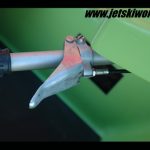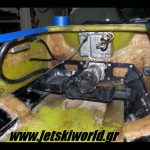The legendary WSAA and WSAB
Kawasaki introduced Jet Skies WSAA and WSAB in 1993, the first ever stand-up watercrafts which were limited in production before the company from Akashi decided to bring them in to mass production in 1976.
Words:Vasilis Moraitis
Photos:www.jetskiworld.gr, Gary Hart
Sourse: KMC, Gary Hart, PWI
There are not many out there in the international personal watercraft scene or jet skiing as it used to be in past that know many things about the history of this sport. Actually, many people including enthusiasts of the sport or even Kawasaki CEO’s in many countries who believe that Kawasaki invented the Stand-Up watercraft. Well, they are wrong since there is only one guy in the world who had this vision and drew it on paper and patent it before actually signing an agreement with Kawasaki to produce the first Stand-Up. It was Clayton Jacobson II, an ex banker from Arizona who started working on this project –the project of personal watercraft- in 1960.
On August 15, 1971, Clayton Jacobson’s agreement with Bombardier had expired and it was that very day that Kawasaki signed an agreement to licence Jacobson’s invention. By this time, Jacobson had already built his seventh prototype stand-up personal watercraft, using a 372ccRotax watercooled engine that was in the 1969 model Sea-Doo. However according to Jacobson, Kawasaki was much more receptive and gave him everything he wanted, including corrosion-resistant materials and a 40hp, 400cc, water-cooled engine. The original engine Kawasaki gave Jacobson was a prototype snowmobile engine and it ended up becoming the foundation for 440cc Jet Ski engine.
When Kawasaki manufactured the very first production stand-up personal watercraft, the term or logo of Jet Ski was not yet in use. Originally it was referred as a “Water Jet” on service manuals and later on as “Power Skies” in the owner’s manual.
Jacobson and Kawasaki created six-to-seven different prototypes in 1972, before bringing two models to the market in 1973, the WSAA and the WSAB. The two original models were made of hand-laid fiberglass and included the 1973 WSAA Jet Ski 400, and the WSAB Jet Ski 400. The WSAA featured a flat bottom design that stayed with the JS hull until 1994. The WSAB featured a V-hull that enhanced turning, but was less stable and harder to ride. Approximately 550 of these, WSAA and WSAB, Jet Skies were ever produced, a third of them with the V hull and the other two-thirds with the flatter WSAA hull.
Fred Tunstall, a long time Kawasaki employee had mentioned in the past that they worked on a half-dozen different prototypes in 1972 before eventually deciding on the two models that would hit the market a year later (1973), the WSAA and WSAB. WSAA featured a hull similar to the one installed later on the JS400 and JS550 models. On the other hand WSAB used an aggressive, deeper-V hull. Kawasaki had worked on a lot of different things back in those days but there are probably about six prototypes they were actually testing. The crafts were fairly similar to each other, though Kawasaki were trying different strake patterns or add sponsons, and other things in order to find out how they respond. There was a lot of trial and error involved in to testing back in 1972.
Why the two hull design?
According to Tunstall, Kawasaki went with the two hulls because they were uncertain about who the customer was going to be. The flat hull was much more stable and easy to use; however there was some thought that the V-hull would attract riders interested in competition. Kawasaki never quite knew what they are going to do, especially in rough water. “Man, that thing could curve. The first ride on it, it is worse than a wild horse, but after you spent some time getting used to it, it turned into a lot of fun.”
Apart from the hull design, the two models were the same. In fact, they share the same dimensions, 6-feet, 10 inches long, 24 inches wide and 26 inches high, with a dry weight of 220 lbs and a draft of 4 inches. Those crafts were only slightly shorter approximately by 2.5 inches and lighter about 25 lbs than the long lived Jet Ski 400.
The 1973 models had a real prototype look, with the wooden bulkhead braces and hand-machined hardware and sand cast aluminum parts. The handlepole was also made of fiberglass, but in two parts which were then riveted together. The first prototypes used –one-piece aluminum tubes but Kawasaki switched to the fiberglass on those first models, which worked pretty well. When Kawasaki moved the Jet Ski production line to Lincoln Nebraska, it switched to SMC (Sheet Molding Compound) and then had a few issues with the handlepoles braking therefore, they pretty much shut down production for almost a year until they solved the problem. The aluminum bars when 30ο bend and featured a trigger throttle lever.
The first engine
WSAA and WSAB featured the same two-stroke, twin-cylinder water-cooled engine which was actually a Kawasaki snowmobile engine. Engine displacement was 398cc with a bore and stroke of 65 x 60 mm and a compression ratio of 5.8:1. On the inlet side there was 2-1 intake manifold toped with a Mikuni, 38mm diaphragm type carburettor with a piston-port intake system. On the exhaust side, a water-jacketed head pipe was fit with a stainless steel expansion chamber.
Horsepower was translated in to thrust via a single stage axial flow aluminum jet pump of 121.7mm. The pump intake was fitted with a cast-in bar scoop which design was based on the same theory of latter’s top-loader intake grates. The pump featured an aluminum three-blade impeller.
Both WSAA and WSAB came standard with a trigger throttle lever like many of today’s personal watercrafts. However the start/stop buttons and the manual choke were situated on the dashboard along with the stainless steel hood latch. The reason behind the awkward position of the start/stop buttons was that at the moment this was the safest way to keep the electric box dry. This was actually one the most important aspects that puzzled Kawasaki engineers back in 1972. Many people assumed it was because so many people started out riding on their knees.
Back in 1993 Kawasaki WSAA and WSAB cost $995 and both craft were the pioneers of Jet Ski that Kawasaki launched in mass production in 1976 with the JS400. These crafts are collectors’ items and among some of ex Kawasaki employees like Tunstall and Bigelow who own those two crafts there are only a few Jet Ski collectors like Gary Hart, and Ty Mc Farland who also include those to their collections. We had visited KMC premises a few years ago and two of those are still on their selves.
Specifications
Kawasaki WS-AA and WS-AB
Model:T1C91
Engine
Type: 2T, vertical twin,180ο firing piston valve, water-cooled
Displacement (cc): 398cc
Bore x stroke (mm): 65 x 60
Power (hp/rpm): 26/6.000
Torque (Ft.Lb/rpm): 24/5.000
Compression ratio: 5.8 :1
Fuel induction system: 1 x Mikuni BN38 diaphragm type
Exhaust system: Cast exhaust wet pipe with a 2-1 header
Cooling system: Engine-Exhaust-Open loop system
Fuel consumption (L/h):5.7 @32kph (1.5gal/hr 20mph)
Hull
Type: Modified V, double concave (model WSAA-Flat hull); Deep V, Double concave (model WSAB).
Hull material: Hand laid fiberglass, with gellcoat finish and wood bulkhead bracing.
Deck Material: Fiberglass reinforced SMC
Overall length (mm): 2.140 (84in)
Overall width (mm): 610 (24 in)
Overall height (mm): 640 (26 in)
Weight (kg): 110 (243 lbs)
Pump and drive line
Pump: Axial flow, single stage, 6-vane.
Pump diameter (mm): 121.7 (4.8in)
Reduction nozzle diameter (mm): 73
Steering nozzle diameter (mm): 84
Impeller: Aluminum, three blade
Thrust (lbs): 220 (100kg)
Fuel/lubrication
Recommend fuel: Regular Unleaded gas, 87+octane rating
Fuel capacity (l): 13 (3.5 gal)
Fuel consumption (l/h at 20mph): 5.67 (1.5 gal/h at 20mph)
Lubrication: Gas/oil Pre-mix, 32:1 ratio
Price: $995 in 1993





























